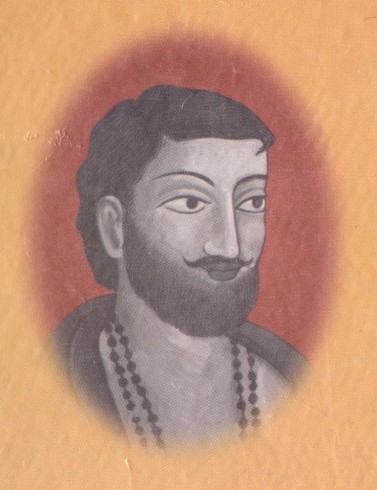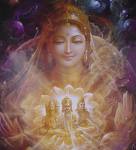Search results for agama (19)
MAKERS OF BENGALI LITERATURE : RAMPRASAD SEN
MAKERS OF BENGALI LITERATURE : RAMPRASAD SEN
ACADEMIC PAPER
“O my heart, you know not cultivation.
This human soil is lying fallow
and it would have produced gold if cultivated”
The Indian concept of culture (Kristi, samaskriti) is defined in the above three lines. “The sharpening of human sensitivities, feelings, emotions, and sensibilities through art is one of various ways by which man can ‘cultivate’ the soil of life to make it yield golden harvest in return”. Thus the poet Ramprasad Sen wrote about the main concept of Indian Culture as stated by Niharranjan Roy.
“No flattery could touch a nature so unapproachable in its simplicity. For in these writings we have perhaps alone in literature, the spectacle of a great poet, whose genius is spent in realizing the emotions of a child.Willam Blake, in our own poetry, strikes the note that is nearest his, and Blake is by no means his peer.
“Robert Burns in his splendid indifference to rank, and Whitman in his glorification of common things, have points of kinship with him. But to such radiant white heart of child-likeness, it would be impossible to find a perfect counterpart.”
– Sister Nivedita (Margaret Noble:1867-1911) on Ramprasad Sen
en.wikipedia.org/wiki/Sister_Nivedita
belurmath.org/kids_section/24-visit-to-niveditas-school
cwsv.belurmath.org/volume_5/questions_and_answers/in_answer_to_nivedita.htm
Ramprasad created a new form of poetry known as ‘Sakta Padabali’ in Bengali, and a new style of singing called ‘Prasadi’. After Ramprasad there was a remarkable outburst of Sakta poetry in Bengal.
His view of life was liberal. He was against racism, castism and untouchability, and generally opposed the Hindu orthodoxies of the conservative society.
Ramprasad believed that there should not be any religious conflict between various sects and cults, since God is one. He wrote, “One in five, five in one mind, should not go into conflicts.” ( ore eke panc, pance ea, non korna sweshasweshi)
Just as the message of Chatanyadeva was spread through his kirtan-singing and dance in the fifteenth century, Ramprasad’s message spread through his songs in the eighteenth century.
The Family
Ramprasad was born in a Baidya (caste of Ayurvedic doctors) familyof West Bengal. Ramprasad’s ancestor Raja Seiharsha Sen, the court physician of Sultan Fakurddin in the fourteenth century, had received the title of Raja from the Sultan.
The family tree:
Sriharsha – Bimal – binayak-Rosh – Narayan – Sangu or Sang – Sarani – Krittibas – Ratnakar – Nityananda – Jaggannath – Jadunandan – Ranjan – Rajiblochon – Jayakrishna – Rameswar – Ramram – Ramprasad.
Ramprasad made reference to his forefathers, especially Krittibas Sen and his father Ramram Sen. The family initially was staying in Dhalahandi in the district of Birbhum, then shifted to Kumarhatta-Halisahar (then in the district of Nadia). His father was a Sanskrit scholar, an Ayurvedician and a poet.
“Tadangaj Ramram mahakobi gunodham
Sada jara sadaya Abhaiya “
Ramprasad also mentioned the scholarly forefathers, who supported many charities.
The family lost their wealth; Ramprasad’s father did not fare well, and died early.
RAMPRASAD’S LIFE AND TIME:
Natha Yogis, Gorakshanath & Kashmir Shaivism
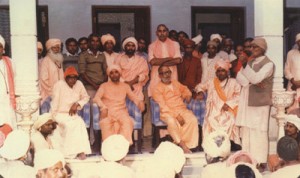
Mela 1985: babaji ( sitting on extreme right), Shri Avaidya nath ji, Shri Chand nath ji
Kundalini Books: Siddha-Siddhantapaddhati of Goraksanatha
Gorakshanath the Originar of Hatha-Yoga
The Sanskrit word nÄ�thá or नाथ, is the proper name of a siddha sampradaya (initiatory tradition) and the word itself literally means „lord, protector, refuge“. The related Sanskrit term Adi Natha means first or original Lord, and is therefore a synonym for Shiva, Mahadeva, or Maheshvara, and beyond these supramental concepts, the Supreme Absolute Reality as the basis supporting all aspects and manifestations of consciousness. The Nath tradition is a heterodox siddha tradition containing many sub-sects. It was founded by Matsyendranath and further developed by Gorakshanath. These two individuals are also revered in Tibetan Buddhism as Mahasiddhas (great adepts) and are credited with great powers and perfected spiritual attainment. Read More: > Here <
Dr. Joachim Reinelt: Zur Zeit des indischen Mittelalters wanderten in weiten Teilen Indiens und Tibets tantrische Mystiker umher, die Nathas, Nathayogis oder Nathasiddhas genannt wurden. Sie praktizierten und lehrten Hatha- und Kundaliniyoga und hatten großen Einfluss auf das religiöse Leben der Menschen.
In meiner Doktorarbeit habe ich die Lehren und Praktiken dieser Yogis untersucht. Als Textgrundlage dient hierbei ein Werk aus dem ca. 13. Jahrhundert, das Vivekadarpana, wörtlich ‚Spiegel der unterscheidenden Betrachtung‘. In diesem recht umfangreichen Werk (21 Kapitel) wurden die Lehren aus unterschiedlichen philosophischen Schulen, Konzepte und Praktiken diverser tantrischer und yogischer Traditionen, sowie viele mythologische Vorstellungen zusammengetragen. www.proyoga.de
Gorakshanatha Saivism: Gorakhnath or Gorakshanatha Saivism is also known as Siddha Siddhanta and Nath tradition. It was founded by Gorakshanatha (Gorakhnath) who lived about 10th century AD. He is believed to be 3rd, 4th or 5th in a line of 12 prominent teachers of this tradition, which has followers in both Buddhism and Hinduism.
He was said to be a disciple of Matsyendranatha who was from in Nepal. Followers of this sect believe that knowledge of this tradition was received by Matsyendranath directly from Siva himself. Gorakshanatha is credited with such works as Siddha Siddhanta Paddhathi and Viveka Martanda. He composed them in Hindi. He also created 12 monastic orders across Northern India in an effort to preserve the Adinatha tradition. Other important works of this tradition are Hathayoga Pradipika, Gheranda Samhita, Siva Samhita and Jnanamrita. Full Article: www.saivism.net
History of the Nathas – The history of ancient Indian sadhu texts reveals a succession of several main groups. There were the Sadhs, Yatis, Siddhas, Nathas, Pashupatis, Sant-Mats, Dasnamis and Nagas. Apart from these, many small sadhu sects have existed and played their part in the great stream of Indian life. In early history, it would appear that some sects were interwoven with others, and some merged or developed into other sects. Some thus became extinct, and others are still with us.
Full Article : http://www.mahendranath.org/yogavidya/yogavidya.html
Address inquiries to:
INTERNATIONAL NATH ORDER
3005 S. Lamar Blvd. D109-387
Austin, TX 78704 (USA)
Yogendranath Yogi Event: „CHATUHSASTHI YOGINI MANTRA -64 KALI YOGINIS“: “Sixty and four are the instruments of enjoyments that tempt the individual soul (jiva). Sixty and four are the divisions (kalas) within jiva; Sixty and four are the chambers of jiva’s chakras; Sixty and four; where Shiva-Shakti are.” In very ancient days, eight great Female Goddesses Shaktis emerged from the cosmic soul of the Principle Dieties and formed Kali Durga, the Universal Shakti Power, These were the grand Mothers (Ashta Matrikas) of all subsequent Yoginis. According to Kaula Tantra, the seight manifested each in turn into eight Divine Shaktis, thus resulting in the 64 Tantric Yoginis.
- Start Time:Sunday, April 10, 2011 at 2:30am
- End Time: Friday, April 10, 2015 at 5:30am
- This is an open event. Anyone can join and invite others to join.
Eight Great Mothers (Ashta Matrikas), Halebid, Karnataka – An examination of the ancient Tantric tradition reveals a particular sanctity assigned to the number eight. The eight mother faculties (tattvas) of the manifested universe, the eight directions with four cardinal and four intermediate points (digbandahs), the eight miraculous yogic powers (siddhis), eight „limbs“ of Yoga (astanga) eight forms of the Divine Mother (matrikas) and eight primary mystic symbols (mudras) are just a few examples. The square of eight, or sixty-four, occupies an even more profound position in the field of Tantra which, from the point of view of the practitioner, first and foremost identifies the sixty-four Tantric Yoginis.
The Matrikas are found in inscriptions uncovered from the Indus Valley Civilization of 5000 years ago.
“O Great Ones, if I am known, what need is there for pilgrimage, austerities and even sadhana itself? If I am revealed, of what use is puja, tantra, kriya, yoga and the revealed texts?
My mystery is grand and broad and expansive beyond the consciousness of humanity, yet I am ever accessible as the cosmic lover beyond the thinking mind and it is I who is the source of the Peace, Light, Love, and Power that are all the hallmarks of my essence. I am the polarities and the forces of creation, the Divine feminine in union with her Lord. Manifesting in both celestial and terrestrial planes, pretending to be limited as a human incarnation, I become intoxicated with all aspects of life, in order to know Shiva as my intimate lover, with whom I always seek oneness.
I take on human incarnation in order that all of his less conscious manifestations might discover their divinity though relationship with me. In doing so I provide an avenue for humanity to taste the nectar of immortality through my Kaula Tantra. Even given this, my true nature still remains secret. I live hidden in the bodies of human lovers, promoting the elevation of consciousness for those who seek it through me.”
2nd Yogendranath Yogi Event „MAHA YOGI GURU GORKHNAHT“: Gorakshya Peeth Siddhachal Mrigasthali, favourite of siddha yogi -guru gorkhnath . Gorakshya Balam, Guru-sishya Palam, Sesha Himalam, Sasikhanda bhalam Kalasya Kalam, Jeeta Janma Jalam, Bandey Jatalam, Jagadabjanalam
- Start Time: Friday, April 8, 2011 at 8:00am
- End Time:Wednesday, April 8, 2015 at 11:00am
- This is an open event, everone can join
Gorakh Nath is also Known as Gorakshya Nath. He is the Yoga power of Lord Shiva, who himself is the whole universe. There are many meanings for the name. First let’s separate the name into smaller parts Go + Rakshya = Gorakshya
The meaning of Go are Cow, Earth (or universe) or the Indriya (Through which person interacts with the outer world also moha or attachment). The meaning of Rakshya is to protect.
The combined meaning becomes as such The one who protects us from the un-escapable net of moha by protecting the indriyas. When all the individual are protected from misutilizing their bodies, which develops the mind so much that we become able to know all the things in the universe, then the universe is protected as a whole.
He is the teacher of Yoga. Yoga means the re-unification of the soul and the super soul (himself). We cannot write about him due to our inefficiency. One of the slokas is listed below which tells something about him.
Tum Sata-Chita-Aananda Sada Shive, Aagama Nigama Parey Yoga Pracharana Karana Yuga Yuga, Gorakh Rupa Dharey You are the super being, Sada Shiva. Farther than the knowledge of Aagama and Nigama. You come here in the form of Gorakh Nath for preaching Yoga (Knowledge for reunification), time to time. The full Bhajan is given in the Bhajan segment of the site.
You can view the big poster of Navanath at Mrigasthali Gorakshya Temple Likewise, there are 84 siddhas. Temples in Nepal and the World – Oom Guru Gorakshya, Mama Rakshya Rakshya Gorakhnath Temple is everywhere in Nepal and India. Gorakshay Nath is very important in the lives of the people so the temple is found in every footsteps. In any urban and rural part of the subcontinent contains Gorakshya temple.
Mrigasthali is another important place for all the Hindus (www.omadesh.org) .It is Known to be the most favourite place for the Lord Shiva to play. This place is listed in uncountable places in the texts of hinduism.
Shiva Gorakshya Meditated at this place for very long time. According to the story, Shiva Gorakshya Meditated here seated on the snakes representing the rain and there was no rainfall for 12 years. He was not happy with the people who was not interested in improving their life with yoga.
The people who were tensed due to no rain thought to bring his Guru Dada Matsyendra Nath and he will wake up and the rain will fall. When they brought Guru Matsyendra Nath from Kamrup Kamakshya then he wake up from meditation and they got the rain fall.
Goraksha Puja // Pandit’s Genocide being completed by indifference of both Center and State Governments.
Yoga – Sanatan Dharma ( > Hinduism <) has always believed that the world began from the god in the form of zero (sunya rup paramatma). But how did that zero became all these? The science cannot explain that thing, yet it has proved that the world is continuously expanding. If it is expanding continuously, then it should have been started from a point or zero. The science also believe this, with Big Bang Theory. But how did something came out of nowhere? The science can never explain this. This is explained by Yoga.
Einstein believed that there is always another antiparticle to some particle. When antiparticle and particle mix together, then there will be nothing. One will consume the other and the whole thing is zero. This thought came out of the sacred texts of Hinduism.
Something out of nothing can come with the power of yoga. The literal meaning of yoga is to mix something together or addition. With the power of yoga, Shiva created the whole universe out of nothing. let us see this in the following table:
0 = 5 – 5
= (5) + (-5)
= ( 3 + 2 ) + (8 – 3)
= (9 – 6 + 4 – 2) + ( 5 + 3 – 5 + 2 )
= ………… and so on (This is addition or Yoga)
Now the world has become a complex one. When the maha-pralaya occurs, the addition occurs and the world again becomes zero, and the new world is started with new mathematics.
Yoga is not the exercise. It is the power of creation. The Rishis of older times developed the science by which anyone can increase the power of yoga within oneself. All the things in Hinduism, world and the universe is within this.
We have to travel through 8.4 million species of plants and animals to become human. We will be promoted or degreded to the next higher level according to our karma. Karma is the form of yoga (Karma-yoga) which increases the yoga power. Shree Shiva Gorakshya is known to be the first sat-guru of yoga. He is Shiva, who came to earth for reason of preaching the knowledge of yoga. He tought 8.4 million postures, by which yoga could be practiced. Among them 84 postures are the most important for Human.
We are trying to publish the 84 yoga postures which could be useful for anyone.
The Gorakhbodh
Questions (Diverse Fragen):
- CREATOR : Yogendranath Nath Yogi <
- EMAIL — yogendranathyogi@gmail.com
- Yogendranath Yogi – ( Ancient Original Natha Yoga) , friends, studies<
- Meet NATH YOGI SAMPRADAYA _ALL WORD <
- Meet YOGA OF NATHA SAMPRADAYA – MAHAYOGACHARYA GORAKHNATH <
- Meet SHRI 108 THANESHWAR NATH MAHAYOGI JAGRTH DHUNA <
- Meet Shri Thaneshwar Nath Namo, Gorakshnath <
Kashmir Shaivism: Kashmiri Arya „Pandits“ are the remainder of a indigenous religious ethnic group (kashmir shaivism philosophy) that originally inhabited the land proclaimed to be paradise by one of many neighbouring Kings . In the ancient times, the indigenous himalaya mountain Nag/“water spring“ tribe and Arya tribes settled and embraced eachothers rituals and values. The Middle ages, the various conquerors named the peoples of this valley as „Pandits“ because they choose the path of peace, enlightenment and knowledge. The Kashmiri Pandits, a „Community in Exile“ , not a caste in exile, retained their cultural identity from the persecution and forced conversion by the invaders of the land since 1300s. There are about 700,000 Kashmiri Pandits/Hindu living worldwide. About less than 5,000 still remain in the Valley of Kashmir. http://en.wikipedia.org/wiki/Kashmir , http://en.wikipedia.org/wiki/Azad_Kashmir
- www.shehjar.com Forgotten Temples of Kashmir <
- KASHMIRI OVERSEAS ASSOCIATION, USA <
- HUMAN UPLIFTMENT THROUGH KASHMIR SHAIVISM <
- Kathak Academy , Shehjar, Kashmir Poetry <
- Yoga Alliance Austria: BYO „Eintreten in das göttliche Bewusstsein“ <
- Yoga Vidya Journal Herbst 2004 < …Der Autor ist Gorak Natha. In einem Antiquariat in London konnten indische …. Lore Tomalla leitet bei Yoga Vidya folgende Seminare …
- Meet Kashmir Pandits, friends, fans, studies at fb <
- Meet Roots in Kashmir, friends, fans at fb <
- Meet Roots in Kashmir Youth worldwide (because Refugees), friends at fb <
- Meet KVKS Kashmiri Visthapit Kalyaan Samiti Health and Education at fb <
- Meet Kashmir Shaivism (Ancient Original Kashmir Yoga), friends and studies at fb <
SRI ADI SANKARA, Yoga, Books, Arts, Studies
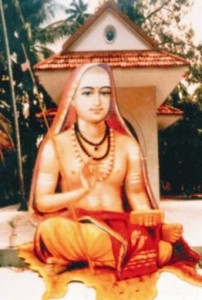
> KAMAKOTI PEETHAM (founded pers. by Sri Sankara) <
> SRI SANKARA UNIVERSITY OF SANSKRIT <
> The Biography by Swami SIVANANDA <
> BHAGAVAD-GITA, commentary of Sri Sankaracharya (1901) <
> KAMAKOTI Go Green Solar Power Project <
Adi Shankara ( DevanÄ�garÄ�: आदि शङ्कर, Ä�di Śaṅkara, pronounced [aːdi ɕaŋkərə]); (788 CE – 820 CE), also known as Śaṅkara BhagavatpÄ�dÄ�cÄ�rya and Ä�di ŚaṅkarÄ�cÄ�rya, was an Indian philosopher who consolidated the doctrine of Advaita Vedanta, a sub-school of Vedanta. His teachings are based on the unity of the soul and Brahman, in which Brahman is viewed as without attributes. He hailed from Kalady of present day Kerala. Shankara travelled across India and other parts of South Asia to propagate his philosophy through discourses and debates with other thinkers. He founded four mathas („monasteries“), which helped in the historical development, revival and spread of Advaita Vedanta. Adi Shankara is believed to be the organizer of the Dashanami monastic order and the founder of the Shanmata tradition of worship.
His works in Sanskrit, all of which are extant today, concern themselves with establishing the doctrine of Advaita (Nondualism). He also established the importance of monastic life as sanctioned in the Upanishads and Brahma Sutra, in a time when the Mimamsa school established strict ritualism and ridiculed monasticism. Shankara relied entirely on the Upanishads for reference concerning Brahman and wrote copious commentaries on the Vedic Canon (Brahma Sutra, Principal Upanishads and Bhagavadgita) in support of his thesis.
The main opponent in his work is the Mimamsa school of thought, though he also offers some arguments against the views of some other schools like Samkhya and certain schools of BUDDHISM that he was familiar with. Read More: > HERE <
Scholastische Phase des Yoga
Diese Phase beginnt mit Shankaracharya (788-820 n. Chr.), der den Vedanta systematisierte und die besten Teile von Samkhya, Yoga und Buddhismus in den Vedanta integrierte. Nach ihm kamen andere Lehrer, die das Prasthana-Trayam anders verstanden, und konkurrierende Vedanta-Schulen gründeten. Advaita-Vedanta – diese von Shankara vertretene Auslegung sieht alle wahrgenommenen Unterschiede der phänomenalen Welt als unwirklich an. Alles was existiert ist nichts anderes als Brahman; doch Brahman hat keine Teile oder Unterschiede in sich. Die wahrgenommenen Unterschiede sind wie eine Fata Morgana. Mehr Lesen/Read More: > Here <
Adi Sankaracharya’s Soundarya Lahari, Translated by P. R. Ramachander: Introduction: Soundarya Lahari meaning waves of beauty consists of two parts viz. Ananda Lahari meaning waves of happiness (first 41 stanzas) and Soundarya Lahari(the next 59 stanzas). It is believed that Lord Ganesha himself has etched the Ananda Lahari on Mount Meru(Some people believe that Sage Pushpa Dhantha did the etching).
It was read from there by Sage Gouda Pada who taught it to Adhi Sankara. Adhi Sankara himself added the rest of the 59 stanzas and completed it.
These 100 stanzas are supposed to be the foremost among Manthra literature. It is also believed that by Making suitable Yanthras ( in west also known as „mandalas…“) and reciting particular stanzas and worshipping the yantras almost anything can be obtained in the world .
- Download at VEDANTA BHERI : >HERE <
- HYMNS ON SANKARA at bhagavadgitausa: >HERE<
- A new light on Adi Sankara, : > HINDU ON NET <,
- HINDU ON NET: > Soundarya Lahari chanting in Bangalore <
- Sankara im Deutschen > Kirchen Lexikon <
There are more than 36 commentries to Soundarya Lahari written in Sanskrit itself. Of them the most famous is that written by Lakshmi Dhara alias Lalla, His commentary is used to understand the meaning of the different verses. Though there are large number of translations and commentaries of Soundraya Lahari available this is perhaps the first time an attempt is made by a mere novice to translate them in to English verse. The aim is to bring to the notice of the devotes who know English better than other languages , the majesty of the medium of worship called >Soundarya Lahari<. A transliteration in roman script is also given. May all those who read this be drenched forever by this “Wave of happiness”.
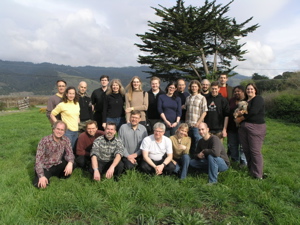
The Internet Archive San Francisco:
The Internet Archive is a 501(c)(3) non-profit that was founded to build an Internet library. Its purposes include offering permanent access for researchers, historians, scholars, people with disabilities, and the general public to historical collections that exist in digital format. Founded in 1996 and located in San Francisco, the Archive has been receiving data donations from Alexa Internet and others. In late 1999, the organization started to grow to include more well-rounded collections.
Now the Internet Archive includes texts, audio, moving images, and software as well as archived web pages in our collections, and is working to provide specialized services relating to training, education, or adaptive reading or information access needs of blind or other persons with disabilities.
Extraordinary Personalities Reflect On The Bhagavad-Gita: > HERE <
Albert Einstein, Mahatma Gandhi, Dr. Albert Schweizer, Aurobindo, Carl Jung, Prime Minister Nehru, Herman Hesse, Vivekananda, Ralph Waldo Emerson, Paramahamsa Yogananda, Rudolph Steiner, Adi Shankara, Aldous Huxley, Ramanuja, Bhaktisiddhanta Saraswati Srila Prabhupada, Baladeva Vidyabhusana, Madhvacarya, and Sri Caitanya Mahaprabhu.
Bhaja Govindam is a very popular 8th century Hindu devotional composition in Sanskrit composed by Adi Shankaracharya. This work of Adi Shankara underscores the view that devotion to God, Govinda, is a vastly important part of general spirituality. This work is generally considered a good summary of Advaita Vedanta.
It is said that Shankara was walking along a street in Varanasi one day, accompanied by his disciples. He heard an old scholar teaching his grammatical rules. Taking pity on him, he went up and advised him not to waste his time on grammar at his age but to turn his mind to God in worship and adoration. The Hymn to Govinda was composed on this occasion. Besides the refrain of the song beginning with the words „Bhaja Govindam“, Shankara is said to have sung twelve verses, hence the hymn bears the title „Dvadasamanjarika-Stotra“ (A hymn which is a bunch of twelve verse-blossoms). The fourteen disciples who were with the Master then are believed to have added one verse each. These fourteen verses are together called „Chaturdasa-manjarika-Stotra“ (A hymn which is a bunch of fourteen verse-blossoms).
The refrain „Bhaja Govindam“ which defines the composition and gives it its name invokes the almighty in the aspect of Vishnu; it is therefore very popular not only with Sri Adi Shankaracharya’s immediate followers, the Smarthas, but also with Vaishnavas and others. There is a story attached to the composition of this Hymn. Please Note: Being a lady > M.S.Subbalakshmi < omitted few verse which are not included in this application.
LORD SIVA AND HIS WORSHIP BY SRI SWAMI SIVANANDA:
VEDIC PATH – MYTHS OF MEDITATION !
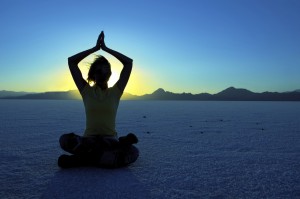
> Myths of Meditation! New light on Dhyana. <
By Yogi Baba Prem Tom Beal, Veda visharada, CYI, C.ay, C.va,
Upanishad
From Hindupedia, the Hindu Encyclopedia www.hindupedia.com
By P.R.Ramachander
The term > „Upanishad“ < literally means the inner or mystic teaching. It is derived from upa (near), ni (down) and s(h)ad (to sit), i.e., sitting down near, which refers to groups of pupils sitting near their teacher to learn from him the secret doctrine. In the serenity of forest hermitages, the Upanishad thinkers pondered on the problems of deepest concerns and communicated their knowledge to the capable pupils that sat near them.
Samkara derives the word Upanishad as a substitute from the root sad, ‚to loosen,‘ ‚to reach‘ or ‚to destroy‘ with Upa and ni as prefixes and kvip as termination. If this determination is accepted, Upanishad means brahma-knowledge by which ignorance is loosened or destroyed. The Upanishads are found in the concluding sections of the Vedas and are classified as Vedanta, or the end of the Vedas.
There are five Vedas and each of these five books has several Saaakas (Branches). Each Saaka has a Karma Khanda dealing with the actions to be performed and is made up of Mantras and Brahmanaas. The latter deals with Upasana or meditation and has Aranyakas * inside them for the benefit of those who have resorted to the quiet habitat of the forest to pursue their spiritual quest.
(*Literature in the ancient period was not fuelled by the urge to preserve history but was a complication of experiences and rules of worship. Most of the literature of this period was religious. (a) The Indigenous literature includes the Vedas, the Brahmanas, the Aryankas, the Upanishads, the Epics Ramayana and Mahabharatha, the Brahmashastras, the Puranas. The Buddhist and Jain literature gives knowledge of the traditions prevalent in those periods. The literature of this period are in Sanskrit Pali Prakrit. It gives us a knowledge about music, dance, painting architecture and administration of various kings.)
The Upanishads are found mostly in the Aranyaka section of the Vedas. The five Vedas have 1180 Saaakas and thus there should be 1180 Upanishads. Of these, what exists today is a collection of 108 Upanishads. The list of these 108 Upanishads is given in the Mukthikopanishad.
Out of the 108 Upanishads, only 10 have been commented upon by several Acharyas like > Adi Shankaracharya < . These are Ishavasya, Kena, Katha, Aithreya, Brihadaranyaka, Prashna, Mandukya, Taittireeya, Chandogya and Mundaka. These have also been popularized by many savants like Swami Vivekananda, Swami Chinmayananda etc. They all deal with highest category of philosophy and metaphysics. Because of this, there is a general impression that all Upanishads are texts of Hindu Philosophy. This is not true. There are Upanishads which even tell you how to wear the sacred ash, how to worship a particular God and so on. But the majority of them deal with methods of Yoga and Renunciation (Sanyasa).
Dhyana Bindhu Upanishad
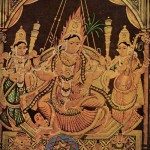
Om ! May He protect us both together; may He nourish us both together;
May we work conjointly with great energy,
May our study be vigorous and effective;
May we not mutually dispute (or may we not hate any).
Om ! Let there be Peace in me !
Let there be Peace in my environment !
Let there be Peace in the forces that act on me !
THE SACRED SYLLABLE „OM“ ACCORDING TO THE UPANISHADS (including dhyana bindu upanishad) , by TYS, Tradtional Yoga Studies, Georg Feuerstein, : > here < .
Aum (also Om, written in Devanagari as ॐ, in Chinese and Japanese as 唵, in Tibetan as ༀ, in Sanskrit known as praṇava प्रणव lit. „to sound out loudly“ or oṃkÄ�ra ओंकार lit. „oṃ syllable“) is a mystical or sacred syllable in the Indian religions, including Hinduism, Sikhism, Jainism and Buddhism, and in Bön.
Aum is commonly pronounced as a long or over-long nasalized close-mid back rounded vowel,) though there are other enunciations pronounced in received traditions. It is placed at the beginning of most Hindu texts as a sacred exclamation to be uttered at the beginning and end of a reading of the Vedas or previously to any prayer or mantra. The Mandukya Upanishad is entirely devoted to the explanation of the syllable. The syllable is taken to consist of three phonemes, a, u and m, variously symbolizing the Three Vedas or the Hindu Trimurti or three stages in life ( birth, life and death ). Though ostensibly in some traditions it is polysyllabic and vocalized as a triphthong, the Omkara is held to move through and contain all vowels possible in human speech.
The name Omkara, (Sanskrit: the syllable om) is taken as a name of God in the Hindu revivalist Arya Samaj. Similarly, the concept of om, called onkar in Punjabi, is found in Sikh theology as a symbol of God. It invariably emphasizes God’s singularity, expressed as Ek Onkar („One Omkara“ or „The Aum is One“), stating that the multiplicity of existence symbolized in the aum syllable is really founded in a singular God.
Read the full text: > HERE <
> Meet Adi Shankara Group at facebook <
P U R A N A S
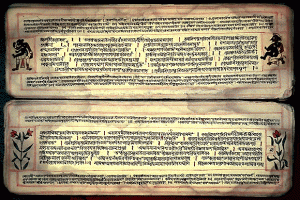
> Hinduism: A Holistic Way of Life <
The Hindu Vedas & Puranas elucidate on not only theology and mytho
Yoga is a way of life, an art of righteous living or an integrated system for the benefit of the body, mind and inner spirit. This art originated, was perfected and practiced in India thousands of years ago.
The references to yoga are available in > ‚Upanishads‘ < and > ‚Puranas‘ < composed by Indian Aryans in the later Vedic and post- Vedic period.
The main credit for systematizing yoga goes to Patanjali who wrote ‚Yoga Sutra‘, two thousand Years ago.
He described the principles of the full eight fold yogic discipline. He composed the treatise in brief code words known as ‚Sutras‘.
Yoga is a way of life, an art of righteous living or an integrated system for the benefit of the body, mind and inner spirit. This art originated, was perfected and practiced in India thousands of years ago. The references to yoga are available in ‚Upanishads‘ and ‚Puranas‘ composed by Indian Aryans in the later Vedic and post- Vedic period.
The main credit for systematizing yoga goes to Patanjali who wrote ‚Yoga Sutra‘, two thousand Years ago. He described the principles of the full eight fold yogic discipline. He composed the treatise in brief code words known as ‚Sutras‘. > ‚Yoga Sutra‘ < is the most important basic text on Yoga. It is through this basic treatise that the essential message of yoga spread throughout the world.
Aim of Yoga is the attainment of the physical, mental and spiritual health. Patanjali has recommended eight stages of Yoga discipline. They are:
-
Yamas- Yamas (abstentions or restrains)
-
Niyamas- Niyamas (observances)-austerities, purity, contentment, study, surrender of the ego
-
Asanas- Physical postures or exercises
-
Pranayama- Control of vital energy (Breathing control)
-
Partyahara- Withdrawal of the senses
-
Dharana- Concentration of the mind (Contemplation)
-
Dhyana- Meditation
-
Samadhi- Attainment of The super conscious state
Quelle Astrojyothi: > The Puranas < are the richest collection of mythology in the world. Most of them attained their final form around 500 A.D. but they were passed on as an oral tradition since the time of Krishna (c. 1500 B.C.).
There are eighteen major Puranas and a few minor ones. Each is a long book consisting of various stories of the Gods and Goddesses, hymns, an outline of ancient history, cosmology, rules of life, rituals, instructions on spiritual knowledge. Hence the Puranas are like encyclopedias of religion and culture and contain material of different levels and degrees of difficulty.
The most important Puranas are the VISHNU PURANA, SHIVA PURANA and MARKENDEYA PURANA (to the Goddess). The BHAGAVATA PURANA is important to the worshippers of Krishna. Other Puranas are the Vayu, Agni, Skanda, Kalki, Linga.
„The Vedas and Puranas are one and the same in purpose. They ascertain the Absolute Truth, which is greater than everything else. The Absolute Truth is ultimately realized as the Absolute Personality of Godhead with absolute controlling power. As such, the Absolute Personality of Godhead must be completely full of opulence, strength, fame, beauty, knowledge and renunciation.“
The Puranas are perhaps the most important or commonly used scriptural texts of the Hindus. They were guide books for the whole of life and society.
- Dein Ayurveda Net: ….. > “ Patanjali „ <
- Dein Ayurveda Net: ….. > “ Ashtanga “ <
- Dein Ayurveda Net: ….. > “ Purana “ <
- Dein Ayurveda Net: ….. > “ Agama“ <
- > Meet Patanjali Groups at facebook <
- > Meet Upanishad Groups and Study at facebook <
A G A M A
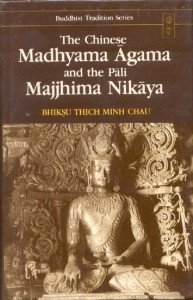
> The Chinese Madhyama Agama & the Pali Majjhima Nikaya <
> AGAMA IN BUDDHISM, JAINISM, HINDUISM <
A G A M A
By Jayaram V
The word „agama“ means authoritative scripture. It was used by > Panini < , the Sanskrit grammarian, as a linguistic term, to describe the formation of certain words. Tantric and Saiva tradition recognizes the agamas as the most authoritative and sacred texts on the methods of worshipping Saguna Iswara or the Brahman with qualities. In a limited sense the agamas are tantric texts containing the principles and practice of Saivism, presented in the form of a teaching by Lord Siva to His consort Parvathi. in contrast, the nigamas, another branch of sacred litetature, depict Parvathi as the teacher and Siva as its recipient. According to the Tantric tradition, the Vedas are nigamas.
Scholars believe that the earliest Agamas were composed during the later Vedic period, when the Vedic rituals were on the decline and Saivism, Vaishnavism and other religious sects were gaining ground. Not all agree with this contention. Some believe the earliest agamas to be much older than the Vedas. There is also an argument that some of the Upanishads and even some portions of the Bhagavadgita were renditions of preexisting agamas. Followers of Siva consider these texts superior to the Vedas. Unlike the Vedas, the Agamas are meant for all castes and sections of society, including women. While the many agamas belong to Saivism and recognize Siva as the Supreme deity, there are also Vaishnava and Shakti agamas which recognize Vishnu and Shakti respectively as the Supreme Iswara.
There is no unanimity as to the actual number of the agamas. Based upon who is recognized as the principal deity, the agamas are divided into Saiva, Vaishnava and Shakti or Tantra agamas. The Pancaratra Agamas and the Vaikanasa Agama belong to the Vaishnava tradition. The Saiva agamas, which contritubuted to the popularity of the southern school of Saiva Siddhanta philosophy and northern school of the Pratyabhijna system of Kashmir Saivism, are divided two distinct categories, namely the 28 Saiva Siddhanta Agamas and 64 Agamas belonging to both the Nakulisa Pasupatha and the Kashmiri Trika schools of Saivism. The > Kaula < , > Mishra < and> Samaya agamas < (and siddhanta texts) are considered to be part of the Shakti tradition. The Vaishnava agama is further divided into Pancharatra and Vaikanasa Agama. The smartas, who acknowledge the Vedas as the supreme and follow the Vedic tradtion, recognize the Agamas, but don’t necessarily adhere to them. In the Malay languages the word Agama literally means religion. The Agamas are also sometimes known as Tantras.
Buchtipp: Bettina Bäumer, Trika: > Grundthemen des kaschmirischen Sivaismus <
There is no unanimity as to what constitue the 28 Agamas of the Saiva Siddhanta schools. According to one classification, of the 28 agamas, ten represent the school of Advaita (monism) or Sivabheda and the rest the school of Vishishtadvaita (qualified monism)or Rudrabheda. The 28 Agamas are listed below:
TANTRA & VEDA: One Tradition
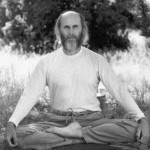
Vedic Light and Tantric Energy Yogas
By David Frawley
Tantra and Veda: One Tradition
A number of writers and teachers, particularly in Western academia, have tried to divide the two great traditions of India of Veda and Tantra as different or even contrary. Some Yoga teachers have uncritically taken up this view as well. They see the Vedic tradition as Aryan and patriarchal and the Tantric tradition as non-Aryan and matriarchal. They identify the Vedic tradition with invading Aryans and the Tantric tradition with indigenous Dravidians. They see the Tantric as worshipping the Mother Goddess and the Vedic as rejecting her. They imply that Vedic and Tantric ideas and practices are very different.
Now that the Aryan Invasion theory is severely in question, and the Sarasvati River of Vedic fame, discovered as the main homeland of civilization in ancient India, we should reexamine these views. In my own more than thirty years of studying Vedic and Tantric texts in the original Sanskrit, I have also found remarkable connections between the two traditions.
Vedic and Tantric traditions are one, though with different orientations. The Vedic tradition is an earlier form of the Tantric, which itself is a later development of Vedic practices. Tantric teachings abound in the use of Vedic mantras and the mysticism of the Sanskrit alphabet. They use Vedic fire altars and practices and honor Vedic deities at an inner level. Inner Tantric Yoga reflects the four main Vedic deities of Agni, Soma, Vayu and Surya (the forces of fire, moon, wind and sun).
VASTU-Purusha & Architektur-Lehre
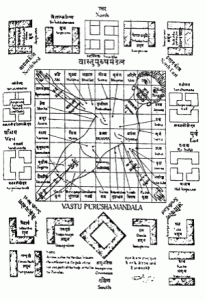
Tantra-Literatur & Vastu-Shastra
> Architektur innerhalb der Kulturen <
* Internationales Astronomiejahr 2009, Sternenfest *
…oder die Idee des Raumes als Spiegel des menschlichen Körpers mit all seinen Strukturen und Proportionen als Teil und Inhalt räumlicher Strukturen.
Gerade in Zeiten wo Orte, das Innen, Aussen, Vergangene Kulturen und Wissenschaften im Hier und Jetzt reges Interesse hervorrufen, ist es vielleicht spannend sich der Architektur und den vielerlei Aspekten bewusst zu werden.
Das es bei Vastu nicht nur darum geht, sich das Wohnzimmer mal nicht nach Feng Shui zu gestalten sondern mal auf „indisch“, und dabei den Blumentopf auf das richtige Fensterbrett zu stellen ist vielleicht einmal eine nähere Betrachtung wert.
Gerade in der Yoga Praxis wird einem innerlich und allgemein oft an Energien bewusst. Über den Fluss dieser (im Ayurveda näher definierten) Energien wird ebenso oft gesprochen.
Antar Mauna – Tantrische Meditation
Yoga Tantra

> Vijnana Bhairava <
Der Zweck von Yoga ist, auf Meditation vorzubereiten. Yoga hat keinen anderen Zweck als den meditativen Zustand möglich zu machen.
Durch diese Methoden entstehen die ‚Nebenwirkungen‘ des Yoga, die Klarheit geben, die Energie erhöhen, Krankheiten und Depression beseitigen oder was sonst im Wege stehen kann, um im meditativen Zustand verbleiben und ihn erleben zu können. Wenn der Körper an Krankheit oder Schmerzen leidet oder wenn Angst oder Sorge den Geist in solch einem Grad beschäftigen, daß sie das einzige sind, womit man sich identifizieren kann, ja, dann muß man Wege finden, um darüber hinwegzukommen.
Veda & Tantra Shastra
> agama shastra, temple worship <
> SIVANANDA – agama, Einführung < > SIVANANDA – tantra yoga <
Santanadharma & Celestial Hierarchy in Christianity
The Veda is the root of all ŚÄ�stras (mūla-śÄ�stra). All others are based on it. The Tantra is spoken of as a fifth Veda. …
When we hear the word ‘Tantra‘, our minds conjure up images of bearded, saffron-clad, ash-smeared faces of ‘aghori babas‘ whose tantric (occult) rituals include eating the flesh of the dead, meditating in cremation grounds and engaging in ‘sacred sex‘. These babas belong to the ‘tamasic‘ branch of Tantra, which is known as ‘Shaakta Pantha‘.
The Tantra Shashtra as defined in our scriptures does not bear any relation to the black arts mentioned above. Our ancients considered Tantra Shashtra as one of the most important Hindu sacred texts and extolled it in their writings. In ancient Hindu scriptures, references to ‘Tantra Shastra‘ and ‘Agama‘ (*)mean the same thing. Let us see what these Agamas tell us.
(*) pronounced ‘Aagama‘ – A as in ‘Arnould‘
saundaryalahari-flood of beauty
The Saundaryalahari
The Saundaryalahari; or, Flood of Beauty – traditionally ascribed to Sankaracarya (vedanta, siehe zB. Beitrag Veden Übersicht, samkhya/vedanta, Yoga Literatur), edited and translated by W. Norman Brown (Cambridge, Mass.: Harvard University Press, 1958).
Tabellarische Übersicht der Veden
Mit Veda (Sanskrit wörtl.: „Wissen“) werden heiligen Schriften bezeichnet. Den Kern des Veda bilden die Texte der Shruti, das sind von Rishis (Weisen) „gehörte“ Texte, also Offenbarungen.
Da es sich um heilige Texte handelt, deren exakte Rezitation wichtig war, wurden sie mit großer Genauigkeit mündlich überliefert. Das Wissen durfte nur an auserwählte Schüler weitergegeben werden. Erst um das 5. nachchristliche Jahrhundert wurden sie niedergeschrieben. Noch heute gibt es Brahmanen, die die Veden auswendig können. Die Bedeutung des Veda ist auch heute noch sehr groß. Es gibt vier Veden: Rigveda, Samaveda, den weißen und den schwarzen Yajurveda und den Atharvaveda.
Mitunter werden die Agamas, aus denen sich die Tantra-Lehre entwickelt hat, als der fünfte Veda bezeichnet.
Die Begriffe „Veda“ und „vedisch“ werden in Indien auch im weiteren Sinne mit der Bedeutung „Wissen“ verwendet und beziehen sich nicht nur auf Texte, sondern auf das religiöse und weltliche Wissen schlechthin.
Die Tradition der vedischen Gesänge wurde von der UNESCO unter die Meisterwerke des mündlichen und immateriellen Erbes der Menschheit aufgenommen.
veda & shastra – klassische Sanskritliteratur
Es gibt vier brahmanische Schriften: VEDA, SMRITI, PURANA, AGAMA. Wobei manche die agamas da sie als Spätwerk gelten zu der vedischen Literatur zählen,- oder nicht.
Weiters unterscheidet man zwischen sechs spirituellen und vier weltlichen Titeln, die da sind: 1) Shruti, 2) Smriti, 3) Itihasa, 4) Purana, 5) Agama und 6) Darshana; und 1) Subhashita, 2) Kavya, 3) Nataka und 4) Alankara.
Die Agamas sind theologische Abhandlungen und praktische Handbücher der Verehrung. Die Agamas beinhalten Tantras, Mantras und Yantras.
annapurna upanishad
annapurna upanishad
Translated by Dr. A. G. Krishna Warrier
Published by The Theosophical Publishing House, Chennai
Om ! O Devas, may we hear with our ears what is auspicious;
May we see with our eyes what is auspicious, O ye worthy of worship !
May we enjoy the term of life allotted by the Devas,
Praising them with our body and limbs steady !
May the glorious Indra bless us !
May the all-knowing Sun bless us !
May Garuda, the thunderbolt for evil, bless us !
May Brihaspati grant us well-being !
Om ! Let there be Peace in me !
Let there be Peace in my environment !
Let there be Peace in the forces that act on me !

